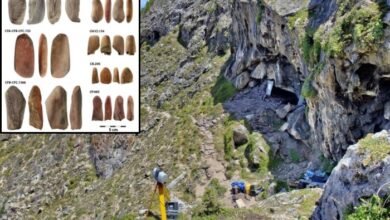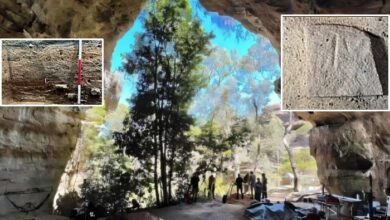Has The Mystery Of Cerne Abbas Giant Been Solved?

Conny Waters – AncientPages.com – A centuries-old mystery may finally have been solved.
Cerne Abbas Giant, the 180ft (55-meter) tall club-wielding man in Dorset, UK, has long been considered a fertility sign due to his large, erect phallus.
The Cerne Abbas Giant was carved out of a chalk hillside above Cerne Abbas village, Dorset, England. Credit: Adobe Stock – David Matthew Lyons
It is not agreed how old the chalk giant hill figure Cerne Abbas Giant is, but the most likely explanation is that he depicts Hercules, the god with superhuman strength. Hence, he was probably created as a pagan idol during the Iron Age in Britain.
As previously discussed on Ancient Pages, the origins and purpose of Britain’s largest and perhaps best-known chalk hill figure has long been a mystery.
Several theories propose the giant figure can be “an ancient spirituality symbol or likeness of Greco-Roman hero Hercules to a caricature of Oliver Cromwell, with the club a reference to repressive rule and the phallus a mockery of his puritanism.
Local folklore has long held it to be a fertility aid and the earliest recorded mention of the giant dates from 1694. The Pitt-Rivers family gifted the giant chalk figure to the National Trust in 1920.
According to new research, the Cerne Abbas Giant in Dorset was originally carved as an image of Hercules to mark a muster station for West Saxon armies.
Previous tests carried out for the National Trust revealed the Cerne Abbas Giant was not as old as scientists thought. The giant chalk hill figure had been carved in the Anglo-Saxon period.
Dr Helen Gittos and Dr Thomas Morcom, who have studied the history of Cerne Abbas Giant, suggest the figure was a response to Vikings’ attacks on Britain. Hercules was well known in the Middle Ages and there was a particular spike of interest in him during the 9th Century, at a time when the area was under attack by Vikings.
“The location of the giant – jutting out from a ridge and close to major routeways – along with its access to fresh water and the supplies of the local estate, would have made it an ideal meeting point for West Saxon armies fighting against the invaders,” the BBC reports.
“This land was owned by the West Saxon royal family in the 9th Century and the 10th Century and we have descriptions of that land.
They describe that there was a herepath – an army road – that led on to Giant Hill and this hillside looks like a special kind of meeting place that we now recognise in the Anglo Saxon landscape,” Dr. Gittos, associate professor in early medieval history,” told the BBC.
The giant is also mentioned in an 11th-century manuscript held at the British Library that refers to a local hermit, Saint Eadwold, planting his staff at the top of the hill.
According to the latest theory, the monks at Cerne Abbey had attempted to rebrand the naked giant as Eadwold in a bid to lay claim to the saint’s relics.
“Having a large, very obviously naked, pagan figure on your doorstep was an inconvenient fact for the monks, and they engaged in a piece of intellectual interpretation, associating him with their patron saint, Eadwold,” Dr. Morcom, the postdoctoral fellow at the University of Oslo, said.
See also: More Archaeology News
Dr Gittos added: “What’s wonderful is that the story we have found is so much more interesting than it being a mystery.
“It tells us so much more about this place and these people and that, for me, is really exciting.”
The findings, by Dr Gittos and Dr Morcom, were due to be published in Speculum the journal of the Medieval Academy of America.
Written by Conny Waters – AncientPages.com Staff Writer





